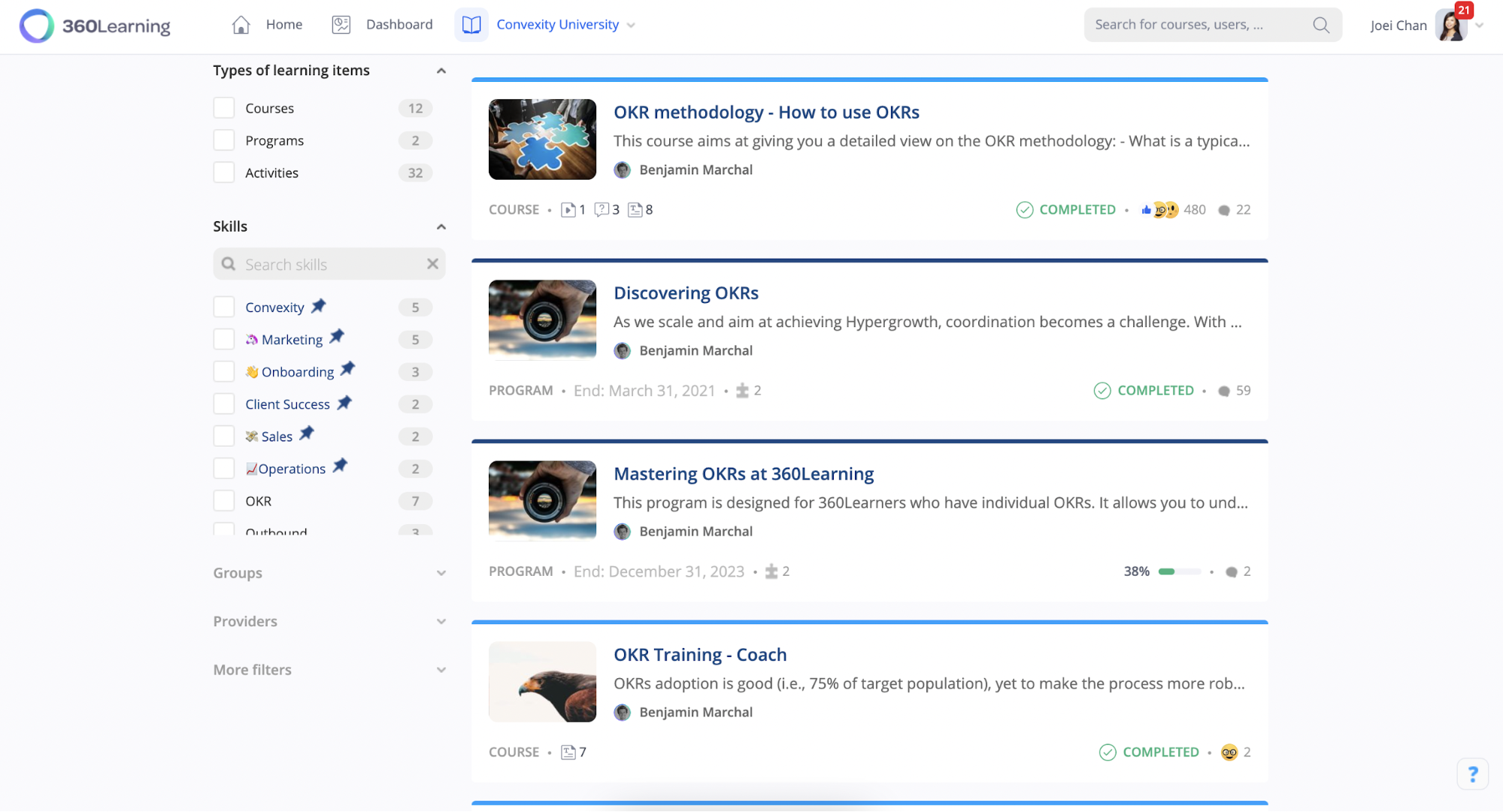
Here’s the OKR Process We Created to Elevate Team Performance (+ a Free OKR Template)
Flexibility in the workplace has taken on a whole new meaning over the last few years. Organizations have made monumental shifts in how—and where—employees work, and with that evolution comes the need to rethink how success is measured for both individuals and teams.
Your employees want to feel like they’re working toward professional development, not just pursuing company growth. A traditional top-down management style where leadership dictates everyone’s goals isn’t the best way to foster employee engagement or productivity. In fact, it can actually be detrimental. McKinsey notes that inflexible or arbitrary goals can demoralize even your most talented employees.
This doesn’t mean you shouldn’t align your workforce around a common vision—far from it. You just need to make room for your people to explore and define their own goals, so they feel empowered and excited about their work.
At 360Learning, we believe the best way to get things done is with a little structure. That’s why we use OKRs (Objectives and Key Results) as a framework for planning our work and tracking our progress throughout the year. We’ve been using them for several years, and we can say with confidence that they really do work—if you know how to work them.

Help your teams overachieve.
By downloading, you agree to our privacy policy.
What makes OKRs so effective?
Objectives and Key Results (OKRs) work because they were designed to be a simple yet powerful way to set goals by outlining a company’s vision and quantifying that vision into measurable results.
The inventor of OKRs, Andy Grove, developed this framework to transform Intel from a producer of memory chips into a leader in semiconductor technology. His goal-setting system focused on defining what steps needed to be taken in order to achieve specific outcomes. Using OKRs, he grew earnings from $1.9 billion to $26 billion.
Unlike other goal-setting systems like Key Performance Indicators (KPIs), OKRs identify common objectives and break them up into measurable components. In contrast, KPIs are often used to set goals for the company as a whole—for example, by establishing a certain profit target or customer retention rate. They measure performance, but they don’t identify specific areas that need attention.
An OKR system also recognizes employees should have a say in where their company should go and how it should get there. This is a departure from the traditional top-down approach to management and is intended to empower workers and cultivate buy-in. Taking this bottom-up approach can help employees—especially younger generations—feel like their personal opinion and development is taken into account at work.
OKRs work because they:
- Give employees a clear focus on what matters most, not just what’s urgent. When teams know what goals they need to focus on, they can prioritize their time and energy accordingly. They’ll know when to say no to a new project that’s exciting but doesn’t move the needle for your company, and instead focus on something that does.
- Build accountability into the work process. OKRs set clear expectations. Managers and leadership can more clearly see if teams are making progress by looking at how they’re performing against these measurable targets.
- Make it easier to measure progress and celebrate success. The OKR process involves defining each key result, so there’s no guesswork involved in figuring out if progress has been made. When achievements can be easily measured, they can be celebrated throughout your organization.
- Give people a shared perspective. When everyone knows what your organization’s overarching goals are, it helps foster a sense of unity. As your team develops their OKRs, they’ll be able to see how their work fits into the bigger picture of the company’s strategy and how their work impacts others.
Why companies fail to make OKRs work
Unfortunately, many companies fail to make goal setting work in practice—just 16% of knowledge workers feel their company sets and communicates company goals successfully. This failure happens because employees don’t have a clear understanding of why they are setting goals, or they don’t understand the purpose behind them.
Here are a few things to keep in mind when setting your OKRs:
- OKRs aren’t KPIs. OKRs have a qualitative and aspirational component that KPIs lack. Confusing OKRs with KPIs will mean that you’ll end up measuring performance without knowing where you actually want to go as a business. KPIs are like your car’s speedometer that tells you how fast you’re going, while OKRs are the GPS system that announces your destination’s location and how to get there.
- OKRs aren’t to-do lists. This is a common misconception about OKRs. If you treat your objectives and key results like a daily to-do or task list, you’ll have no idea whether these actions are producing the results your company needs to grow. Performing tasks and checking them off a list isn’t the same as working toward a specific set of results.
- Lack of team alignment. Team OKRs that aren’t aligned will hinder overall growth because competing priorities will slow everyone down. Misalignments can even lower performance in other areas by creating internal friction or dependencies.
Our process for writing, implementing, and managing OKRs
A few years ago, we found ourselves at the critical juncture of growing so fast that we needed an objective-setting framework better suited for rapid growth. We knew it was time to get serious about performance management and decided to embrace the OKR system.
How 360Learning writes OKRs
OKRs are a fantastic tool for setting goals, tracking progress, and measuring results, but what about the nuts and bolts of actually defining them on an ongoing basis? Here’s the approach we take for writing OKRs:
We start by identifying company-wide goals
This is the most top-down part of the whole process, but it’s necessary to ensure global alignment. Our board, CEO, and other C-suite members identify, then communicate their high-level objectives for our company. We use this company-wide vision as the bedrock for the rest of our OKRs.
For your company, this might look like: “become the best project management software in the United States” or “help businesses reduce their carbon footprint by 50% in the next decade.”
We break those goals down into team objectives
We added this extra step to try and narrow the gap between objectives at the company and individual levels. “Team objectives” are, as they sound, the goals for a certain department. They should answer the question, “Where do I want to go?” For example, an OKR objective for a SaaS marketing team could be “Increase the number of product-qualified leads by three times.”
There should be a strong bottom-up element to setting team objectives. Team members should be encouraged to suggest their own ideas and work with their manager to settle on the right ones.
We turn team objectives into individual objectives and break them down into key results
Just like team objectives, these should answer the same question—but on an individual level. Again, a bottom-up approach here is key. If we follow the same OKR example as above, an individual objective could be, “grow the team by 50% in Q2,” “establish our brand narrative within six months,” or something similar.
Key results, as opposed to objectives, are quantifiable by definition. While objectives address the question, “Where do we want to go?” key results answer the question, “How do we know we’re there?” Key results look like “reaching the top-10 spot for an SEO ranking,” “generating 2,000 sales qualified leads in Q3,” or “boosting website traffic by 30% in the next 120 days.”
We list initiatives within key results and create daily to-do lists to help us accomplish them
Listing initiatives was another step we added to make our objectives even more granular and straightforward to execute. An initiative answers the question, “What do I need to do to reach a key result?” Each person should have a small list of projects that are independent and can be delivered in a short period of time (a week or two, max). Good examples would be “post four blog articles a week” or “host three webinars per quarter.”
The most granular piece to the OKR framework is daily to-do lists. These are the everyday activities you can keep track of in Trello (as we do) or whatever tool you have in place to accomplish your initiatives. The main thing to remember is to keep your objectives qualitative and aspirational and your key results quantifiable. This way, you have the freedom to iterate on your initiatives and to-do lists to make sure they’re contributing to acing your key results.
How 360Learning implements OKRs
Our Head of Operations and McKinsey veteran led the charge by developing the following three-step system to roll out OKRs in a matter of months:
We start OKR training at onboarding
Your teams may be familiar with OKRs, but they may not fully understand them. To make sure everyone starts off on the same page, our employee onboarding process includes a course devoted to understanding and writing OKRs.
Every new employee must pass this course. To do so, they need to write their own, real-life OKRs for their first quarter at 360Learning. This assignment gives them the chance to put into practice what they learned in theory.

We incorporate OKRs into the flow of work
People often go through their weekly to-do list, only opening an OKR reporting file once a month—or less—to scribble some disconnected progress notes. This is a missed opportunity. Instead, it’s essential that the OKRs are embedded in your team and company culture and anchored in daily activities.
At 360Learning, this meant integrating our OKRs into the tools we use every day:
- Trello for project management
- Google Sheets for tracking
- Our own platform, 360Learning, for communication, training, and alignment
We take things step by step to gain buy-in
The first step covers your new team members, but what about your existing employees? If you’ve been using another kind of goal-setting framework (or none at all), you’ll need a plan to gain buy-in and minimize resistance.
For us, that meant going slowly and gradually establishing an OKR system. We launched a month-long pilot program before implementing the system in earnest, and we made sure to communicate the benefits of using OKRs loud and clear to everyone in our company.
How 360Learning manages OKRs
The development of OKRs should be a top-down as well as bottom-up exercise, but managers still play a key role in facilitating buy-in and making sure OKRs have a positive impact on your company’s performance.
Managers match team goals with individual goals
Employees want their business to do well, but they also want to reach their own personal or professional growth goals. Ideally, OKRs should be aligned not only with the company and team’s objectives but also with professional development goals for individuals. This way, employees are always working toward something that matters to them personally.
Managers use 1:1s with direct reports to continuously improve OKRs
Many discussions about OKR ideas and professional development will happen during your one-on-ones. The more productive these meetings are, the more likely you are to write better OKRs that stick and promote company growth.
Direct reports are the experts on their scopes—so we advise our managers to let them lead the discussion. Managers structure the meeting and take notes to stay focused and aligned. As you adopt this approach, you can also ask employees to prepare a few topics beforehand by thinking about their biggest challenges and opportunities for growth this quarter or year, then use those as a starting point for discussion.
Build and implement your own OKRs with our free template
OKRs offer companies in all industries a way to set high-level goals and align every division, team, and individual for maximum growth. If you don’t know where to begin, you can use the steps outlined in this post to implement the OKR system and drive better organizational performance—simply adjust it based on your objectives and the specific requirements of your teams.
Looking for more of a head start? Here’s the OKR template we use at 360Learning. Have a go—you might only be one task away from implementing the best goal-setting framework your company has ever seen.

Help your teams overachieve.
By downloading, you agree to our privacy policy.

